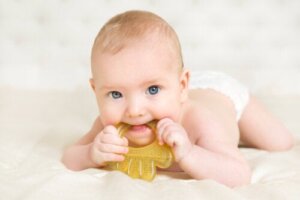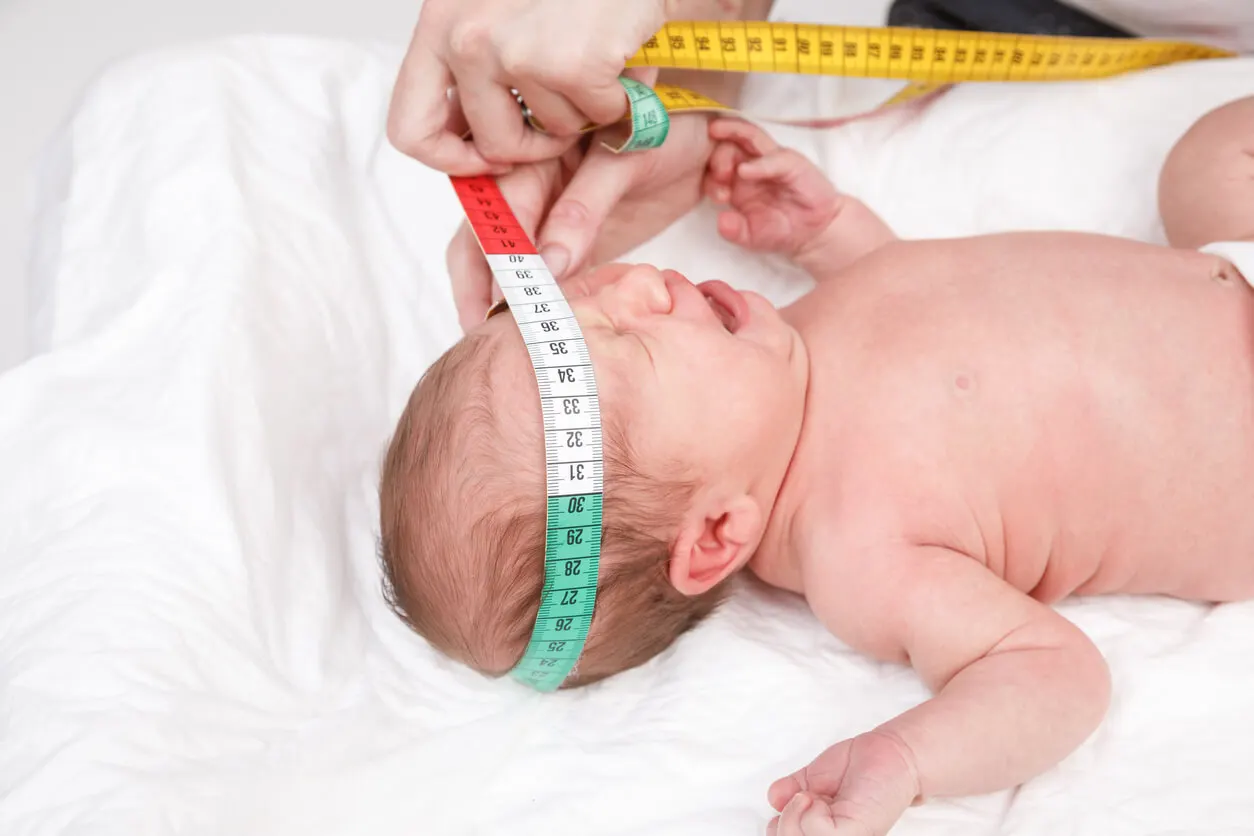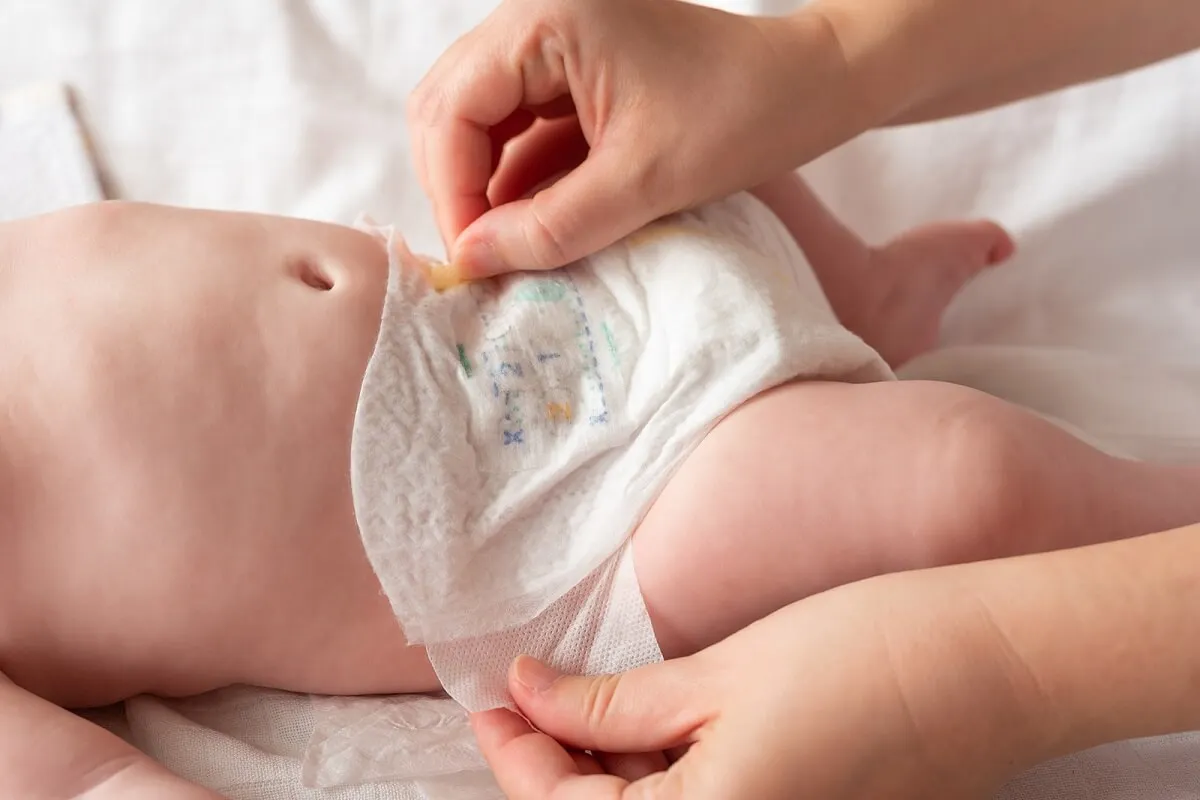Weight, Sleep, and Development in 4-month-old Babies


Reviewed and approved by the nurse Leidy Mora Molina
4-month-old babies have already started on their way to independence, although this is not yet very marked. They have acquired new physical, cognitive, and psychosocial skills.
It’s very important to follow your child at each stage of development. After all, there are patterns common to most children. The most advisable thing to do is to take note of the changes and relevant advances of the 4-month-old baby. This information will be very useful in consultations with their pediatrician.
The weight of 4-month-old babies
The first element to take into account is the weight of 4-month-old babies. Here, it’s also important to take note of their height and head circumference.
It’s possible for a baby to be a little above or below normal and still not have a problem. There’s only cause for concern if the difference is very significant.
Overall, the reference values are as follows:
- Weight: 4-month-old male infants should be between 5.6 and 8.8 kilograms. Meanwhile, girls should be between 5 and 8.1 kilograms.
- Size: Boys should measure between 59.9 and 68 centimeters at 4 months. On the other hand, girls should measure between 57.8 and 66.2 centimeters.
- Head circumference: This is the measurement of the distance around the head. In boys, it should be between 40.5 and 42.8 centimeters. In girls, it should be between 39.3 and 41.8 centimeters.
On average, 4-month-old babies should have a weight gain of about 600 grams over the previous month. If the weight, length, or head circumference are different from the figures given above, the pediatrician will take note of it.

Sleep in 4-month-old babies
Babies at 4 months usually sleep between 8 and 10 hours at night and about 6 hours during the day. The latter is usually spread over 3 or 4 naps.
However, they typically don’t have a very stable sleep pattern yet. That’s why they may wake up at night or exchange nighttime habits for daytime ones. Their circadian rhythms are just getting going.
If the mother has to go back to work, the little ones may feel restless, and this may disturb their rhythms. In some cases, the first discomfort in the gums appears, which also affects the way they sleep.
It’s a good idea to help the baby to have a stable schedule. Some tips to help them adopt a correct pattern are as follows:
- If he or she wakes up too early, leave the baby in his crib so he or she can sleep a little longer.
- Keep the room where he or she sleeps with low lighting.
- Don’t make noises so as not to wake the baby up during his or her rest.
Like this article? You may also like to read: The Importance of Crawling for your Baby’s Development
The physical development of 4-month-old babies
4-month-old babies begin to develop color vision, a skill they will complete by 6 months. They look at faces more closely, no longer just looking at the eyes, but at the whole face. They also distinguish sounds such as their mother’s and father’s voices and music they like.
At this age, they have more control over their head and can hold it upright. When lying down, they can bend their neck forward to look at their feet. If they’re face down, they lean on their open hands. They are beginning to learn to roll over.
4-month-old babies prefer to sit up because that position allows them to see everything around them. However, they’re not yet able to hold this position on their own.
Other reflexes and skills they develop include the following:
- They have better eye-hand-object coordination. They open their hand in anticipation to grab what they want. They pass toys from one hand to another without dropping them.
- They put objects in their mouths. In this way, they explore and develop their perception.
- They’re able to support themselves on their elbows and forearms when they’re face down.
We think you may be interested in reading this, too: Commercial Baby Food May Be Contaminated with Heavy Metals, Report Shows
Cognitive and psychosocial development
Babies at 4 months begin the development of their sociability. As a result, they no longer want to be alone and usually cry when their mother leaves and calm down when she returns. They may show some shyness around strangers.
At this age, they spend a lot of time observing their surroundings. Let’s see what other cognitive skills and psychosocial advances they make.
Social and emotional development in 4-month-old babies
4-month-old babies often smile when something pleasant happens to them, such as a token of affection or a reaction to being tickled. They also smile at their own image in the mirror. They gurgle and babble to get attention.
On the other hand, they suck their fist when they are hungry, which is a way of reassuring themselves. They become active and excited when someone familiar approaches them.
Cognitive development
Before, they only focused on the food while eating. Now even a slight sound gets their attention. At 4 months old, babies also spend a lot of time examining their own hands or feet.
At this age, they begin to learn routines. They repeat them when they’re pleasurable. They can also predict them. For example, they flex their hips when they notice it’s time for a diaper change.

Stimulation for 4-month-old babies
A good way to stimulate the development of 4-month-old babies is to talk to them often. They love to be talked to and begin to respond.
In addition, it’s important that they have the opportunity to interact with their toys safely. Colorful toys are very important at this age. They should be allowed to put them in their mouths, as this is their way of exploring them.
It’s also a good idea to encourage their sociability. It’s a good idea to invite another mother with her baby and have them both spend some time together. It may seem like babies don’t interact with each other, but in reality, they’re taking note of everything.
Always be attentive to the child
Parents and caregivers are the closest people to a baby. Therefore, they’re the ones who can best follow the baby’s development. That’s why it is important to be attentive to all the baby’s changes in growth and development.
If the baby can’t hold his or her head upright or grasp objects, does not smile or follow people with his or her eyes, or doesn’t babble or respond to sounds, it’s necessary to consult your pediatrician to see what’s going on.
All cited sources were thoroughly reviewed by our team to ensure their quality, reliability, currency, and validity. The bibliography of this article was considered reliable and of academic or scientific accuracy.
- American Academy of Sleep Medicine (s.f.). Child Sleep Duration Health Advisory. Consultado el 30 de junio de 2023. https://aasm.org/advocacy/position-statements/child-sleep-duration-health-advisory/
- Asociación Española de Pediatría (2014). Crecimiento de los niños en los primeros años de vida. En Familia. Consultado el 11 de junio de 2023. https://enfamilia.aeped.es/edades-etapas/crecimiento-ninos-en-primeros-anos-vida
- Gómez-Andrés, D., Pulido, I., Fiz, L. (2015). Desarrollo neurológico normal del niño. Pediatría Integral, 19(9), 640.e1-640.e7. https://www.pediatriaintegral.es/publicacion-2015-11/desarrollo-neurologico-normal-del-nino/
- Institute for the Advancement of Breastfeeding & Lactation Education. Sueño Normal de los Bebés y Lactancia. Consultado el 30 de junio de 2023. https://lacted.org/iable-breastfeeding-education-handouts/sueno-normal-de-los-bebes-y-lactancia/
- Organización Mundial de la Salud (s.f.). Child growth standards. Consultado el 30 de junio de 2023. https://www.who.int/tools/child-growth-standards
- Pin, G., & Lluch, A. (2011). El sueño en el primer año de vida: ¿cómo lo enfocamos? Pediatría Atención Primaria, 13(S20), 101-111. http://scielo.isciii.es/scielo.php?script=sci_arttext&pid=S1139-76322011000400011&lng=es&tlng=es
- Torres, Y., Ramos, V., Tortoló, S. (2016). Los juguetes como medio de desarrollo del niño de la primera infancia. Atenas, 1(33). https://www.redalyc.org/journal/4780/478049736011/html/
- Manchay, C. (2020). Desarrollo de los reflejos en niños menores de un año [Tesis de Segunda Especialidad Profesional de Educación Inicial, Universidad Nacional de Tumbes]. Repositorio Digital UNTUMBES. http://repositorio.untumbes.edu.pe/handle/20.500.12874/1965
- American Academy of Ophthalmology. (2020). Desarrollo de la visión: recién nacido hasta los 12 meses. Consultado el 23 de junio de 2023. https://www.aao.org/salud-ocular/consejos/desarrollo-de-la-visi%C3%B3n-reci%C3%A9n-nacido-hasta-los-12
- American Academy of Pediatrics. (2016). El desarrollo de la visión del bebé: ¿qué pueden ver los bebés?. Healthy Children. Consultado el 23 de junio de 2023. https://www.healthychildren.org/Spanish/ages-stages/baby/Paginas/babys-vision-development.aspx?gclid=CjwKCAjwhdWkBhBZEiwA1ibLmGEPWpH8bGMzv9nX6RNQbRFlXhmH-WMx1TxEfxNzyF9eg4rSUs4ymxoCRFsQAvD_BwE
- Centros para el Control y la Prevención de Enfermedades. (2023). Indicadores importantes: su bebé a los 4 meses. Consultado el 23 de junio de 2023. https://www.cdc.gov/ncbddd/spanish/actearly/milestones/milestones-4mo.html
This text is provided for informational purposes only and does not replace consultation with a professional. If in doubt, consult your specialist.








